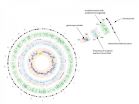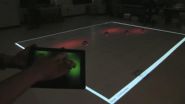(Press-News.org) They are 'strange' materials, insulators on the inside and conductors on the surface. They also have properties that make them excellent candidates for the development of spintronics ('spin-based electronics') and more in general quantum computing. However, they are also elusive as their properties are extremely difficult to observe. Now a SISSA study, published in Physical Review Letters, proposes a new family of materials whose topological state can be directly observed experimentally, thus simplifying things for researchers.
"What interests us of topological insulators is not so much that their being insulators but that they exhibit conducting states on their surface" explains SISSA researcher Massimo Capone. "This features makes them unique, as none of the other insulating or conducting materials exhibits this dichotomy. Unfortunately, the characteristics that describe these materials are very subtle, such that they are truly difficult to identify and study". The latest paper by Capone and co-workers published in Physical Review Letters explains how such characteristics could be found in materials with more evident properties, thus simplifying research in this field and opening up new possibilities.
The mathematical explanation of why some materials are insulators and others are conductors was one of the first tangible results of the theory of quantum mechanics. Quantum mechanical models postulate that, in solids, the atoms making up the material may only have certain energy states ("positions" where the electrons spin around the nucleus) but not others. "Possible and impossible states alternate in a band pattern", explains Capone. "In insulators some bands are completely "occupied", and others are empty, whereas in conductors some empty places remain within a band". Topological insulators resemble normal insulators, with the difference that the energy states are inverted. "It's as if the bands contained artificial holes", continues Capone.
Conduction in these materials is strange for another reason as well. "The electrons contained in the energy layers have a spin, which we can think of as a direction of rotation around their axis. In a metal (a conductor), the electrons driven by an electrical field normally move in the same direction, independent of their spin, whereas in these topological insulators electrons with opposite spin propagate in opposite directions", says Adriano Amaricci, another SISSA researcher involved in the project. "This feature makes them attractive for spintronics". In fact, in electronics the information is encoded in sequences or strings of 0's and 1's, which correspond to "on" and "off" states, whereas in spintronics the 0's and 1's correspond to the type of spin, which may be only "up" or "down". Topological insulators could constitute the material basis for this alphabet.
More in detail...
The feature distinguishing topological insulators from a normal metal is very abstract and elusive. "To have an idea, try to compare this situation with the difference between a magnetic and non-magnetic state. The latter is a difference that can easily be measured", explains Amaricci.
The properties of topological insulators are instead abstract and mathematically defined, so it is difficult to know when we are dealing with such a material. "Through the use of a mathematical model and simulations, we demonstrated that new topological insulators can be found in materials that exhibit 'spectacular' features that are easily detected owing to strong electron-electron interactions" continues Amaricci. "This way, it will be easier to identify these materials experimentally, to then better investigate this important field of research".
Very important indeed, according to Capone: "the scientist who discovered these materials, in 2007, was Laurens Molenkamp who, according to rumours circulating in the research community, is a likely candidate for a future Nobel Prize". Molenkamp works at the University of Würzburg, which took part in the current study. Together with colleagues in Würzburg, and in particular Sangiovanni and Trauzettel, it might be possible to involve Molenkamp himself in the future developments of this research project.
INFORMATION:
A gap year between high school and the start of university studies does not weaken young people's enthusiasm to study or their overall performance once the studies have commenced. On the other hand, adolescents who continue to university studies directly after upper secondary school are more resilient in their studies and more committed to the study goals. However, young people who transfer directly to university are more stressed than those who start their studies after a gap year. These research results have been achieved in the Academy of Finland's research programme ...
In a study published this month in Malaria Journal, researchers from Uppsala University and other institutions present a new model for systematically evaluating new malaria treatment programs in routine conditions across multiple countries.
Despite major investments in malaria rapid diagnostic tests (RDT) in recent years, there remains limited evidence of their impact on treatment decisions in routine program conditions. Evidence to date is largely derived from small-scale facility studies conducted within a limited number of countries, notably Kenya, Malawi, Tanzania, ...
It is six times more expensive for society - and for you individually - if you travel by car instead of cycling. This has been shown in a Lund University study of Copenhagen, a city of cyclists. It is the first time a price has been put on car use as compared to cycling.
In the comparative study, Stefan Gössling from Lund University and Andy S. Choi from the University of Queensland have investigated a cost-benefit analysis that the Copenhagen Municipality uses to determine whether new cycling infrastructure should be built.
It considers how much cars cost society ...
Offenders enrolled in alcohol treatment programmes as part of their sentence are significantly less likely to be charged or reconvicted in the 12 months following their programme, a study led by Plymouth University has shown.
Researchers from the University's School of Psychology led a project, supported by the European Social Fund, which saw males with alcohol problems related to offending being assigned to a range of different treatments when convicted.
They then calculated the participants' charged and reconviction rates over the following year, with the results ...
This news release is available in German.
Mainz-based researchers have made significant advances with regard to the development of individualized immunotherapy strategies for treating cancer. They have managed to identify the relevant genetic changes or mutations associated with various types of cancer and have determined their individual blueprints. This makes it possible for the scientists to readily produce customized cancer vaccines of the kind that have already been demonstrated to be effective in animal models. Here they have proven effective in the regression ...
PITTSBURGH--Bragging to coworkers about a recent promotion, or posting a photo of your brand new car on Facebook, may seem like harmless ways to share good news.
However, a new study from City University London, Carnegie Mellon University and Bocconi University shows that self-promotion or a "humblebrag" often backfires.
Published in Psychological Science, Irene Scopelliti, George Loewenstein and Joachim Vosgerau wanted to find out why so many people frequently get the trade-off between self-promotion and modesty wrong. They found that self-promoters overestimate how ...
Pollution from historic mining activities in south west England has led to a reduction in genetic diversity of brown trout according to new research from the University of Exeter. The findings, which will be published on Friday 15 May in the journal Evolutionary Applications, indicate that human activity can alter the genetic patterns of wild populations - an important issue in modern conservation.
The prevalence of metal contaminants in rivers across the south west of England is directly linked to mining activities dating back hundreds of years. Exposure to high concentrations ...
Today's imagery from NASA's AIRS instrument on the Aqua satellite indicates more severe weather is in store for the Midwest from Texas to Michigan. There is another extremely strong storm that is stretching from south to north and into Canada, and that system can be seen in this AIRS image from May 11, 2015. The first image (left) was taken at 3:35 am EDT, by the time the second image (right) was taken at 2:41 pm EDT the system had come together and was stretching across the nation vertically across the country.
Current weather forecasting predicts that Monday evening ...
CORVALLIS, Ore. - Researchers have discovered why many animal species can spend their whole lives outdoors with no apparent concern about high levels of solar exposure: they make their own sunscreen.
The findings, published today in the journal eLife by scientists from Oregon State University, found that many fish, amphibians, reptiles, and birds can naturally produce a compound called gadusol, which among other biologic activities provides protection from the ultraviolet, or sun-burning component of sunlight.
The researchers also believe that this ability may have ...
Using a smart tablet and a red beam of light, Georgia Institute of Technology researchers have created a system that allows people to control a fleet of robots with the swipe of a finger. A person taps the tablet to control where the beam of light appears on a floor. The swarm robots then roll toward the illumination, constantly communicating with each other and deciding how to evenly cover the lit area. When the person swipes the tablet to drag the light across the floor, the robots follow. If the operator puts two fingers in different locations on the tablet, the machines ...



